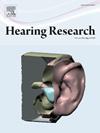听觉脑干反应的一种自动阈值分割算法
IF 2.5
2区 医学
Q1 AUDIOLOGY & SPEECH-LANGUAGE PATHOLOGY
引用次数: 0
摘要
听性脑干反应(ABR)是衡量耳蜗、听性脑干和中脑总体健康状况的重要诊断指标,被广泛用于基础研究和临床研究。ABR 的一个关键量化指标是阈值,即能引起反应的最低声级。由于 ABR 波形的形态会随着刺激水平的变化而改变,而且总体信噪比较低,因此阈值估计并不简单。虽然已经提出了几种算法方法,但目前的标准做法仍然是将 ABR 波形作为刺激水平的函数进行目测评估。我们开发了一种基于对同一刺激的两个独立平均响应的交叉相关算法。对于每个刺激水平,对每个音调点的单独反应会被随机分成两组。计算每组波形的中位数,然后得到这些中位数波形之间的归一化交叉相关性。此过程重复 500 次,以获得重新采样的交叉相关分布。对于每个频率,计算每个级别的这些分布的平均值,并用 sigmoid 或幂律函数进行拟合,以估计阈值。算法阈值表现出稳健而准确的性能,在大量小鼠数据池中,人类评级阈值的准确率达到 92%,在 ±10 dB 范围内。在大量的小鼠数据中,算法阈值的准确率达到了 92%,在±10 dB 的范围内,这一表现优于已发表的几种算法在同一数据集上的表现。在临床前研究中,该算法已完全取代了人工估计 ABR 阈值的方法,从而节省了大量时间,提高了研究过程的客观性。本文章由计算机程序翻译,如有差异,请以英文原文为准。
ABRpresto: An algorithm for automatic thresholding of the Auditory Brainstem Response using resampled cross-correlation across subaverages
The Auditory Brainstem Response (ABR) is an essential diagnostic indicator of overall health of cochlea, auditory brainstem and midbrain, used extensively in both basic research and clinical studies. A key quantification of the ABR is threshold, the lowest sound level that elicits a response. Because the morphology of ABR waveforms shift with stimulus level and the overall signal-to-noise ratio is low, threshold estimation is not straightforward. Although several algorithmic approaches have been proposed, the current standard practice remains the visual evaluation of ABR waveforms as a function of stimulus level.
We developed an algorithm based on the cross-correlation of two independent averages of responses to the same stimulus. For each stimulus level, the individual responses to each tone-pip are randomly split into two groups. The median waveform for each group is calculated, and then the normalized cross-correlation between these median waveforms is obtained. This process is repeated 500 times to obtain a resampled cross-correlation distribution. For each frequency, the mean values of these distributions are computed for each level and fit with a sigmoid or a power law function to estimate the threshold.
Algorithmic thresholds demonstrated robust and accurate performance, achieving 92% accuracy within ±10 dB of human-rated thresholds on a large pool of mouse data. This performance was better than that of several published algorithms on the same dataset. This algorithm has now fully replaced the manual estimation of ABR thresholds for our preclinical studies, thereby saving significant time and enhancing objectivity in the process.
求助全文
通过发布文献求助,成功后即可免费获取论文全文。
去求助
来源期刊

Hearing Research
医学-耳鼻喉科学
CiteScore
5.30
自引率
14.30%
发文量
163
审稿时长
75 days
期刊介绍:
The aim of the journal is to provide a forum for papers concerned with basic peripheral and central auditory mechanisms. Emphasis is on experimental and clinical studies, but theoretical and methodological papers will also be considered. The journal publishes original research papers, review and mini- review articles, rapid communications, method/protocol and perspective articles.
Papers submitted should deal with auditory anatomy, physiology, psychophysics, imaging, modeling and behavioural studies in animals and humans, as well as hearing aids and cochlear implants. Papers dealing with the vestibular system are also considered for publication. Papers on comparative aspects of hearing and on effects of drugs and environmental contaminants on hearing function will also be considered. Clinical papers will be accepted when they contribute to the understanding of normal and pathological hearing functions.
 求助内容:
求助内容: 应助结果提醒方式:
应助结果提醒方式:


